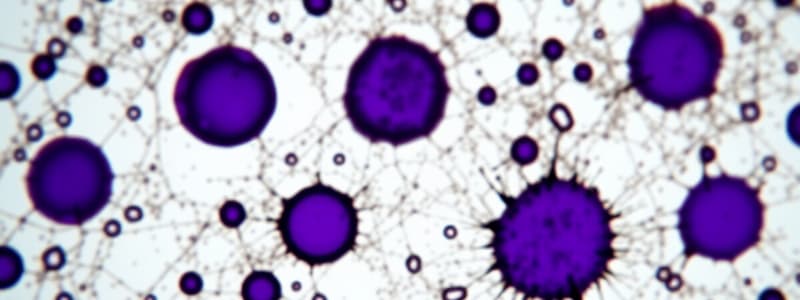Podcast
Questions and Answers
What is the purpose of adding a loopful of water to the slide during smear preparation?
What is the purpose of adding a loopful of water to the slide during smear preparation?
- To kill the bacteria
- To create a suspension and spread the bacteria (correct)
- To stain the bacteria
- To heat-fix the bacteria
Heat is used to dry the smear during preparation.
Heat is used to dry the smear during preparation.
False (B)
What is added to the water on the slide to create a suspension?
What is added to the water on the slide to create a suspension?
inoculum
The primary stain used in the procedure described is Carbol ________.
The primary stain used in the procedure described is Carbol ________.
What should be done before watching the linked video?
What should be done before watching the linked video?
Flashcards
Smear Preparation
Smear Preparation
A thin layer of bacteria spread on a slide for staining and viewing under a microscope.
Loopful of Water
Loopful of Water
A small amount of liquid, usually water, used to create a bacterial suspension on a slide for smear preparation.
Bacterial Suspension
Bacterial Suspension
Adding bacteria to water to create a suspension on the slide.
Air Drying Smear
Air Drying Smear
Signup and view all the flashcards
Carbol Fuchsin
Carbol Fuchsin
Signup and view all the flashcards
Study Notes
- Inoculation and transfer techniques aseptically is covered in session 2.
- Bacterial characterization includes differential media, biochemical tests and other tests in future sessions
- Session 1 involves microscopy.
- Session 3 invloves preparing slides for different staining treatments (simple, differential, special)
Smear Preparation Steps
- A loopful of water is added to the slide to create a suspension to spread the bactera
- Add inoculum to the drop of water to create a suspension
- Air dry the slide for less than 10 minutes
- Heat fix the air-dried smear by passing thr slide through the flame about 3 times
Gram Staining Summary
- Gram staining involves the use of crystal violet, iodine, alcohol, and safranin to stain the bacteria
- Crystal violet stains all cells purple
- Iodine acts as a mordant, helping to keep the primary stain bound to the cell
- Gram-negative bacteria lose the primary stain upon rinsing with alcohol
- Safranin is used as a counterstain
- Gram-negative bacteria appears pink/red
- Gram-postive bacteria appers purple
Acid-Fast Staining
- Used as a differential stain to distinguish organisms with waxy cell walls
- Acid-fast bacteria contain mycolic acid, a waxy substance that makes it difficult for cells to react to gram staining
- Mycolic acid makes the bacteria impermeable to some staining procedures
- Cells that retain a basic stain when rinsed with acid-alcohol, are termed acid-fast positive cells
- Cells will lose the stain when rinsed with acid-alcohol are termed non-acid-fast cells
- Non-acid-fast cells are counterstained to see it in contrast with acid-fast cells
Two Well-Known Acid-Fast Staining Methods
Ziehl-Neelsen Method:
- Uses carbol fuschin as the primary stain with phenol to help solubilize the cell wall
- Heat is used as a mordant
- Uses acid-alcohol to decolorize
- Uses Methylene blue as the counterstain
- Acid-fast cells appear red and non-acid-fast cells appear blue
Kinyoun Method
- Uses carbol fuchsin as the primary stain which has a higher concentration of phenol
- No heat is sued
- Uses acid-alcohol to decolorize
- uses brilliant green as the counterstain
- Acid-fast cells appear red, and non-acid-fast cells appear green
Acid-Fast Stain (ZN Method Steps)
- Begin with a heat-fixed smear
- Apply primary stain with carbol fuchsin
- Apply heat to increase stain penetration
- All cell types will take up the primary stain
- Decolorize the cells with acid-alcohol, except for acid-fast bacteria
- Apply Methylene blue to counterstain any cells which have been decolorized
- Acid-fast cells will be reddish, and non-acid fast cells will be blue
Procedure for the Ziehl-Neelsen Stain
- Prepare smears of organisms and heat fix the smear
- Place slide on the staining rack then cover with a small paper towel soaked with carbol fuschin and allow to stand for 30 to 60 seconds
- Heat gently until slight steaming is observed then maintain steaming for five minutes while adding more dye as needed to prevent drying of the smear
- Cool teh slide then remove the paper and rinse with water
- Decolorize slowly using an acid-alcohol then rinse with running water
- Cover with methylene blue for one minute and rinse with water
- Blot dry and observe
Mycobacterium
- This is bacteria is an example of acid-fast positive cells
- Mycobacterium tuberculosis leads to tuberculosis
- Mycobacterium leprae leads to Leprosy or Hansen's disease
- Mycobacterium smegmatis is non-pathogenic
- Norcadia
M. Tuberculosis
- Etiologic agent of tuberculosis in humans and humans are the only reservoir for it
- Leading cause of death in the world from a bacterial infectious disease
- Affects 1.8 billion people/year which is a third of the world's population
- More likely to be found in those with AIDS
Lab Activities
- Prepare smears of Staphylococcus aureus and Mycobacterium smegmatis
- Ziehl-Neelsen stain is to be performed on the bacterial sample
- Microscopy to inspect the sample
Important materials to use in todays Lab
- Beaker with tap water
- Bunsen burner
- Slide
- Carbol Fuchsin
- Acid alcohol
- Methylene blue
- Forceps
- Water bottle
- Staining tray
- Paper towels
- Inoculation loops
- Hot plate
Studying That Suits You
Use AI to generate personalized quizzes and flashcards to suit your learning preferences.




